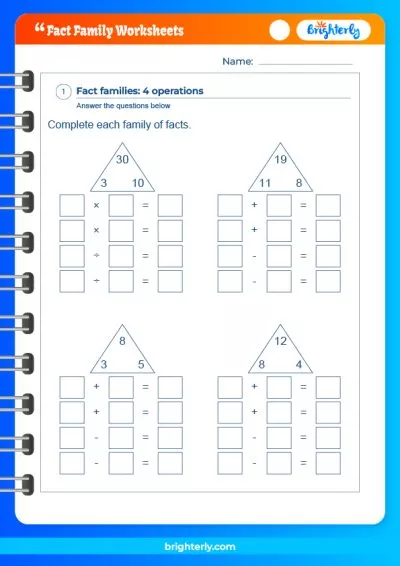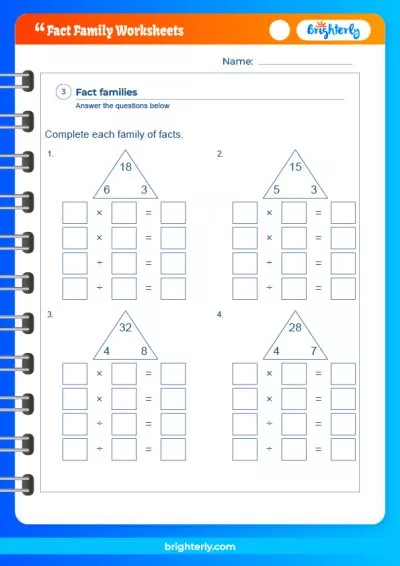Fact Family
Created on Jan 07, 2024
Updated on January 7, 2024
Through the unique and engaging approach of Brighterly, children can explore the connections between numbers in a fun and intuitive way, encouraging them to view math as an exciting adventure. Fact families are essential for demonstrating how numbers and operations interrelate, equipping students with the tools to manipulate numbers through different operations to achieve new results. This fundamental understanding plays a crucial role in building mathematical comprehension and fostering a love for learning.
What Is a Fact Family?
A Fact Family is a fascinating concept in the world of mathematics that helps children build a strong foundation for understanding basic operations. It consists of three numbers that are related in a particular way. Think of them as members of a family, where the relationships between them allow us to create mathematical equations. Fact families are essential because they show how numbers and operations are connected. They help students understand that numbers can be manipulated through different operations to yield new results, which is a vital part of mathematical comprehension. Understanding fact families can also make mental calculations easier, as it encourages seeing patterns and relationships in numbers rather than memorizing individual facts.
Fact Family Definition
A Fact Family is a set of math facts that involves the same numbers. More specifically, it’s a group of related addition/subtraction or multiplication/division facts that use the same numbers. For example, in an addition/subtraction fact family with the numbers 2, 3, and 5, we could write 2 + 3 = 5, 3 + 2 = 5, 5 – 2 = 3, and 5 – 3 = 2. Each of these equations is a ‘fact’ in the ‘family’. Similarly, in a multiplication/division fact family, if we use the numbers 2, 3, and 6, we could write 2 x 3 = 6, 3 x 2 = 6, 6 ÷ 2 = 3, and 6 ÷ 3 = 2. Fact families can be a powerful tool to help children understand the inverse relationship between addition and subtraction, and multiplication and division.
Fact Family Triangle
A Fact Family Triangle is a visual tool that assists children in understanding fact families. Imagine a triangle with one number at the top and two at the base. The number at the top is the result of adding or multiplying the two base numbers, while the base numbers are the results of subtracting or dividing the top number. This simple diagram is a powerful visual aid for understanding how the numbers in a fact family interact, helping students to understand and remember the relationships between them. The fact family triangle is a bridge between concrete and abstract thinking, making it easier for children to grasp mathematical concepts.
You can find the answers and more practice questions in our Fact Family Worksheets.
Addition and Subtraction Fact Family
An Addition and Subtraction Fact Family uses the same numbers to create both addition and subtraction facts. This helps children understand that addition and subtraction are inverse operations. For instance, if we have the numbers 4, 5, and 9, we can make the addition facts 4 + 5 = 9 and 5 + 4 = 9, and the subtraction facts 9 – 5 = 4 and 9 – 4 = 5. By practicing with these fact families, children can better understand and remember their addition and subtraction facts, which is a fundamental skill in mathematics.
Multiplication and Division Fact Family
A Multiplication and Division Fact Family similarly uses the same numbers to create both multiplication and division facts. This helps students understand that multiplication and division are also inverse operations. For example, if we have the numbers 2, 3, and 6, we can make the multiplication facts 2 x 3 = 6 and 3 x 2 = 6, and the division facts 6 ÷ 3 = 2 and 6 ÷ 2 = 3. Just as with addition and subtraction fact families, practicing with multiplication and division fact families can help children to grasp and retain their multiplication and division facts, which are essential for more complex mathematical operations.
Solved Examples on Fact Family
To illustrate the concept of a Fact Family, let’s consider a few solved examples.
For instance, let’s take the numbers 3, 4, and 7. In the addition/subtraction fact family, the facts would be: 3 + 4 = 7, 4 + 3 = 7, 7 – 4 = 3, and 7 – 3 = 4.
In the case of multiplication/division, let’s take the numbers 2, 5, and 10. The facts would be: 2 x 5 = 10, 5 x 2 = 10, 10 ÷ 5 = 2, and 10 ÷ 2 = 5.
These examples clearly demonstrate how the numbers in a fact family are related through addition/subtraction or multiplication/division.
Practice Problems on Fact Family
Practice is a key part of mastering the concept of Fact Families. Here are a few practice problems:
- Create an addition/subtraction fact family using the numbers 6, 7, and 13.
- Create a multiplication/division fact family using the numbers 3, 7, and 21.
- Given the addition fact 8 + 2 = 10, what other facts belong to this fact family?
These practice problems will help children to apply their understanding of fact families and reinforce the inverse relationships between addition/subtraction and multiplication/division.
Conclusion
Fact Families are an indispensable concept in elementary mathematics, and here at Brighterly, we are committed to helping children develop a deep understanding of the relationships between numbers and operations. By delving into addition/subtraction and multiplication/division fact families, students can enhance their mental calculation skills, gain a more profound understanding of mathematical concepts, and ignite a passion for mathematics that will last a lifetime.
At Brighterly, we believe that every child deserves the opportunity to explore the fascinating world of mathematics in a supportive and engaging environment. Our innovative approach to teaching fact families and other essential concepts is designed to make learning enjoyable and accessible for all children. We understand that mastering the fundamentals of mathematics is the key to unlocking countless opportunities in the future, and we are dedicated to helping each and every child on their journey to success. With Brighterly, your child’s future has never been brighter.
Frequently Asked Questions on Fact Family
What is a Fact Family?
A Fact Family is a set of related math facts that involve the same numbers. These math facts can be based on addition/subtraction or multiplication/division. By using the same numbers in different combinations, children can learn how these operations are interconnected, and they can gain a deeper understanding of the relationships between numbers in various mathematical contexts.
Why are Fact Families important?
Fact Families play a significant role in a child’s mathematical development for several reasons:
- They help students understand the inverse relationship between addition and subtraction, as well as multiplication and division.
- Fact Families provide a framework for recognizing patterns and relationships in numbers, which can aid in mental calculation skills.
- By working with Fact Families, children can develop a more robust number sense and improve their overall problem-solving abilities.
- Fact Families serve as a foundation for mastering more complex mathematical concepts later in a child’s education.
Overall, Fact Families contribute to a solid foundation in arithmetic, enabling children to confidently approach more advanced mathematical concepts.
How do you create a Fact Family?
To create a Fact Family, you need three numbers that are related in a particular way:
- In an addition/subtraction fact family, the larger number is the sum of the two smaller numbers. For example, if you have the numbers 3, 4, and 7, you can create addition facts 3 + 4 = 7 and 4 + 3 = 7, and subtraction facts 7 – 4 = 3 and 7 – 3 = 4.
- In a multiplication/division fact family, the largest number is the product of the two smaller numbers. For example, with the numbers 2, 5, and 10, you can create multiplication facts 2 x 5 = 10 and 5 x 2 = 10, and division facts 10 ÷ 5 = 2 and 10 ÷ 2 = 5.
Information Sources
Information for this blog post was gathered from a variety of reliable sources, including:






